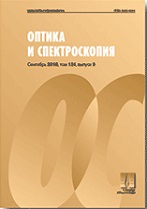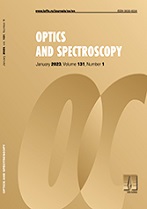|
Spectroscopy and physics of atoms and molecules
Narrowing of the absorption line of light alkali metal atoms in an atmosphere of heavy inert gases at growing radiation intensity
A. I. Parkhomenkoa, A.M. Shalaginab
a Institute of Automation and Electrometry, Siberian Branch, Russian Academy of Sciences, 630090, Novosibirsk, Russia
b Novosibirsk State University, 630090, Novosibirsk, Russia
Abstract:
The effect of narrowing of the absorption line of light alkali metal $^{7}\mathrm{Li}$ and $^{23}\mathrm{Na}$ atoms present in an atmosphere of heavy inert gas (xenon) with an increase in the external radiation intensity has been investigated. For $^{7}\mathrm{Li}$ atoms at temperature $T=300$ K and buffer gas $(\mathrm{Xe})$ pressure $p_{\mathrm{Xe}}=0.002$ Torr, the linewidth at half maximum decreases by a factor of $1.20$ with an increase in the radiation intensity from $1\mu$W/cm$^2$ to $2.5$ mW/cm$^2$. For $^{23}\mathrm{Na}$ atoms at $T=600$ K and $p_{\mathrm{Xe}}=0.01$ Torr, the linewidth at half maximum decreases by a factor of $1.29$ with an increase in the radiation intensity from $1\mu$W/cm$^2$ to $6$ mW/cm$^2$. The effect of field narrowing of the absorption line is due to the following factors. First, the collisional relaxation of the velocities of light resonance particles in an atmosphere of heavy buffer particles is divided into two stages with significantly different durations: relaxation in the velocity direction (fast stage) and relaxation in the velocity magnitude (slow stage). Second, there are no collisional transitions between hyperfine components of the ground state.
Keywords:
lithium, sodium, buffer gas, collision, absorption line.
Received: 19.03.2019
Revised: 31.05.2019
Accepted: 11.06.2019
Citation:
A. I. Parkhomenko, A.M. Shalagin, “Narrowing of the absorption line of light alkali metal atoms in an atmosphere of heavy inert gases at growing radiation intensity”, Optics and Spectroscopy, 127:5 (2019), 721–729; Optics and Spectroscopy, 127:5 (2019), 783–791
Linking options:
https://www.mathnet.ru/eng/os542 https://www.mathnet.ru/eng/os/v127/i5/p721
|


| Statistics & downloads: |
| Abstract page: | 25 |
|





 Contact us:
Contact us: Terms of Use
Terms of Use
 Registration to the website
Registration to the website Logotypes
Logotypes








 Citation in format
Citation in format 